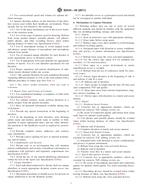Potrebujeme váš súhlas na využitie jednotlivých dát, aby sa vám okrem iného mohli ukazovať informácie týkajúce sa vašich záujmov. Súhlas udelíte kliknutím na tlačidlo „OK“.
ASTM E1588-10e1
Standard Guide for Gunshot Residue Analysis by Scanning Electron Microscopy/ Energy Dispersive X-ray Spectrometry (Includes all amendments And changes 3/15/2016).
Automaticky preložený názov:
Štandardné príručka pre výstrel rezíduí analýzu o Snímacie elektrónové mikroskopia / Energy Dispersive X-ray spektrometria
NORMA vydaná dňa 1.6.2010
Informácie o norme:
Označenie normy: ASTM E1588-10e1
Poznámka: NEPLATNÁ
Dátum vydania normy: 1.6.2010
Kód tovaru: NS-42272
Počet strán: 5
Približná hmotnosť: 15 g (0.03 libier)
Krajina: Americká technická norma
Kategória: Technické normy ASTM
Kategórie - podobné normy:
Anotácia textu normy ASTM E1588-10e1 :
Keywords:
energy dispersive X-ray spectrometry, forensic science, gunshot residue, scanning electron microscopy, Energy-dispersive spectroscopy (EDS), Guns, Gunshot residue (GSR), Residue, Scanning electron microscope (SEM), ICS Number Code 11.020 (Medical sciences and health care facilities in general)
Doplňujúce informácie
| Significance and Use | ||
|
This document will be of use to forensic laboratory personnel who are involved in the analysis of GSR samples by SEM/EDS (4). SEM/EDS analysis of GSR is a non-destructive method that provides (5, 6) both morphological information and the elemental profiles of individual particles. Particle analysis contrasts with bulk sample methods, such as atomic absorption spectrophotometry (AAS) (7), neutron activation analysis (NAA) (8), inductively coupled plasma atomic emission spectrometry (ICP-AES), and inductively coupled plasma mass spectrometry (ICP-MS), where the sampled material is dissolved or extracted prior to the determination of total element concentrations, thereby sacrificing morphological information and individual particle identification. X-ray fluorescence spectrometry (XRF) is a technique that has been used to map the placement and distribution of GSR particles surrounding bullet holes in order to establish shooting distances (9). Unlike the solution-based bulk methods of analysis, XRF is non-destructive; however, XRF still does not provide morphological information and is incapable of individual GSR particle identification. |
||
| 1. Scope | ||
|
1.1 This guide covers the analysis of gunshot residue (GSR) by scanning electron microscopy/energy-dispersive X-ray spectrometry (SEM/EDS) by manual and automated methods. The analysis may be performed manually, with the operator manipulating the microscope controls and the EDS system software, or in an automated fashion, where some amount of the analysis is controlled by pre-set software functions. 1.2 Since software and hardware formats vary among commercial systems, guidelines will be offered in the most general terms possible. For proper terminology and operation, consult the SEM/EDS system manuals for each system. 1.3 The values stated in SI units are to be regarded as standard. No other units of measurement are included in this standard. 1.4 This standard does not purport to address all of the safety concerns, if any, associated with its use. It is the responsibility of the user of this standard to establish appropriate safety and health practices and determine the applicability of regulatory limitations prior to use. |
||
| 2. Referenced Documents | ||
|
Podobné normy:
Historická
1.11.2009
Historická
1.3.2010
Historická
15.9.2010
Historická
1.7.2011
Historická
1.3.2011
Historická
1.12.2009
Odporúčame:
Aktualizácia zákonov
Chcete mať istotu o platnosti využívaných predpisov?
Ponúkame Vám riešenie, aby ste mohli používať stále platné (aktuálne) legislatívne predpisy
Chcete vedieť viac informácií ? Pozrite sa na túto stránku.



 ASTM E2195-09
ASTM E2195-09 ASTM E2212-02a(2010)..
ASTM E2212-02a(2010).. ASTM E2224-10
ASTM E2224-10 ASTM E2344-04(2011)..
ASTM E2344-04(2011).. ASTM E2388-11
ASTM E2388-11 ASTM E2439-09
ASTM E2439-09
 Cookies
Cookies
